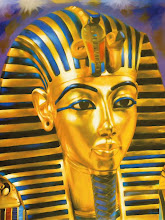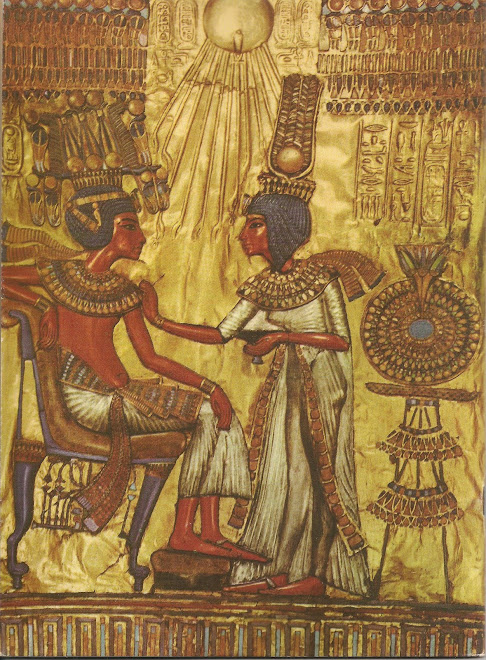sábado, 10 de março de 2012
Egipto - História * Arte * Simbolismo
General Info About The Subject Of The Book:
Ancient Egypt was an ancient civilization of Northeastern Africa, concentrated along the lower reaches of the Nile River in what is now the modern country of Egypt. Egyptian civilization coalesced around 3150 BC (according to conventional Egyptian chronology)[1] with the political unification of Upper and Lower Egypt under the first pharaoh.[2] The history of ancient Egypt occurred in a series of stable Kingdoms, separated by periods of relative instability known as Intermediate Periods: the Old Kingdom of the Early Bronze Age, the Middle Kingdom of the Middle Bronze Age and the New Kingdom of the Late Bronze Age. Egypt reached the pinnacle of its power during the New Kingdom, in the Ramesside period, after which it entered a period of slow decline. Egypt was conquered by a succession of foreign powers in this Late Period. In the aftermath of Alexander the Great's death, one of his generals, Ptolemy Soter, established himself as the new ruler of Egypt. This Ptolemaic Dynasty ruled Egypt until 30 BC, when it fell to the Roman Empire and became a Roman province.[3]
The success of ancient Egyptian civilization came partly from its ability to adapt to the conditions of the Nile River Valley. The predictable flooding and controlled irrigation of the fertile valley produced surplus crops, which fueled social development and culture. With resources to spare, the administration sponsored mineral exploitation of the valley and surrounding desert regions, the early development of an independent writing system, the organization of collective construction and agricultural projects, trade with surrounding regions, and a military intended to defeat foreign enemies and assert Egyptian dominance. Motivating and organizing these activities was a bureaucracy of elite scribes, religious leaders, and administrators under the control of a Pharaoh who ensured the cooperation and unity of the Egyptian people in the context of an elaborate system of religious beliefs.[4][5]
The many achievements of the ancient Egyptians include the quarrying, surveying and construction techniques that facilitated the building of monumental pyramids, temples, and obelisks; a system of mathematics, a practical and effective system of medicine, irrigation systems and agricultural production techniques, the first known ships,[6] Egyptian faience and glass technology, new forms of literature, and the earliest known peace treaty.[7] Egypt left a lasting legacy. Its art and architecture were widely copied, and its antiquities carried off to far corners of the world. Its monumental ruins have inspired the imaginations of travellers and writers for centuries. A new-found respect for antiquities and excavations in the early modern period led to the scientific investigation of Egyptian civilization and a greater appreciation of its cultural legacy.[8]
Contents
1 History
1.1 Predynastic period
1.2 Early Dynastic Period (c. 3050 –2686 BC)
1.3 Old Kingdom (2686–2181 BC)
1.4 First Intermediate Period (2181–1991 BC)
1.5 Middle Kingdom (2134–1690 BC)
1.6 Second Intermediate Period (1674–1549 BC) and the Hyksos
1.7 New Kingdom (1549–1069 BC)
1.8 Third Intermediate Period (1069 – 653 BC)
1.9 Late Period (672 – 332 BC)
1.10 Ptolemaic dynasty
1.11 Roman Period
1.12 Arab Muslim Conquest
2 Government and economy
2.1 Administration and commerce
2.2 Social status
2.3 Legal system
2.4 Agriculture
2.4.1 Animals
2.5 Natural resources
2.6 Trade
3 Language
3.1 Historical development
3.2 Sounds and grammar
3.3 Writing
3.4 Literature
4 Culture
4.1 Daily life
4.2 Cuisine
4.3 Architecture
4.4 Art
4.5 Religious beliefs
4.6 Burial customs
4.7 Military
5 Technology, medicine, and mathematics
5.1 Technology
5.2 Faience and glass
5.3 Medicine
5.4 Shipbuilding
5.5 Mathematics
6 Legacy
7 See also
8 Notes
9 References
10 Further reading
11 External links
Extract And Contents Taken From: http://en.wikipedia.org/wiki/Ancient_Egypt
Subscrever:
Enviar feedback (Atom)

+001.jpg)
+001.jpg)
+001.jpg)

.jpg)
.jpg)





















+001.jpg)



+001.jpg)





+001.jpg)

+001.jpg)

+001.jpg)

+001.jpg)
+001.jpg)
.jpg)



Sem comentários:
Enviar um comentário
Nota: só um membro deste blogue pode publicar um comentário.